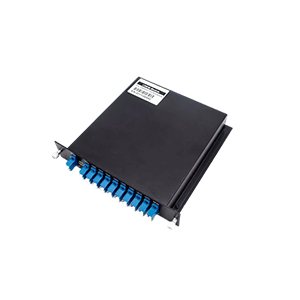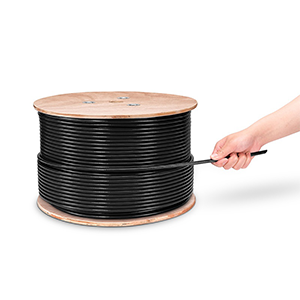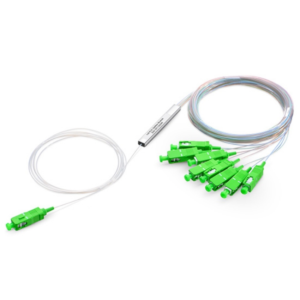Thank you very much for choosing to read this article. Today I will introduce to you AOC (Active Optical Cable) and its important role in high-speed data transmission. AOC is an innovative solution that plays a key role in high-speed data transmission through the process of photoelectric conversion and electro-optical conversion. Let’s take a deeper look at the advantages and features of AOC compared to traditional fiber optic cables.
AOC Cables Overview
AOC (Active Optical Cable) is an active optical cable that converts optical signals into electrical signals through optoelectronic devices (optical modules) and transmits electrical signals through copper wires. AOC plays an important role in high-speed data transmission.
The role of AOC in high-speed data transmission:
-
High-speed data transmission: AOC is widely used in scenarios that require high-speed data transmission, such as data centers, computer networks, storage systems, and high-performance computing. It supports data transmission rates up to dozens of Gbps (or even hundreds of Gbps), which can meet the needs of large-capacity data transmission.
-
Long-distance transmission: AOC is capable of transmitting data over long distances, usually up to tens to hundreds of meters. In contrast, traditional copper cables are limited by electrical signal attenuation and interference, and cannot maintain the quality and stability of high-speed data transmission over long distances.
-
Low latency: AOC has low transmission latency, which is very important for applications that require high real-time performance, such as high-performance computing, cloud computing, and virtual reality.
Overall, AOC plays an important role in high-speed data transmission and has the advantages of flexibility, lightweight, anti-interference, and saving time and effort. It is a high-performance solution that meets the requirements of modern data transmission needs.
How AOC Cables works
The working principle of AOC (Active Optical Cable) is based on the process of photoelectric conversion and electro-optical conversion. Here is a brief introduction to how AOC works:
-
Optical-to-Electrical Conversion: One end of the AOC contains an optical module, which receives the optical signal from the light source and converts it into an electrical signal. Optical modules usually consist of lasers, photodetectors and related electronic equipment. Lasers convert electrical signals into optical signals, which are then transmitted through optical fibers. At the other end, a photodetector receives the light signal and converts it into an electrical signal.
-
Electrical-to-Optical Conversion: The other end of the AOC contains an electrical module, which receives the electrical signal from the electrical signal source and converts it into an optical signal. Electrical modules typically consist of electrical modulators and associated electronics. The electrical modulator modulates the intensity and frequency of the optical signal according to the intensity and frequency of the electrical signal, and then transmits it through the optical fiber. At the other end, the optical signal is received by an optical receiver and converted into an electrical signal.
Through the process of photoelectric conversion and electro-optical conversion, AOC realizes the mutual conversion between optical signals and electrical signals, thereby realizing data transmission.
How AOC achieves high-speed data transmission and long-distance transmission capabilities:
-
High-speed data transmission: AOC uses optoelectronic devices and high-speed electronic equipment to support high-speed data transmission. The design and technology of optical modules and electrical modules enable AOC to reach data transmission rates of tens of Gbps or even hundreds of Gbps, meeting the demand for large-capacity data transmission.
-
Long-distance transmission: AOC uses optical fiber as the transmission medium. The transmission loss of light is small and it can maintain high transmission quality and stability over long distances. In addition, AOC uses optoelectronic devices to amplify and regenerate optical signals, which can overcome the limitations of traditional copper cables in long-distance transmission and achieve transmission distances of tens to hundreds of meters.
What are the advantages of AOC Cables
AOC (Active Optical Cable) has many advantages over copper cables and traditional optical fiber cables, including high bandwidth, low latency and anti-interference capabilities. The following is a detailed discussion of its advantages and highlights the application advantages of AOC in data centers and high-performance computing environments:
-
High bandwidth: AOC can provide high-bandwidth data transmission capabilities. It supports data transmission rates of up to dozens of Gbps or even hundreds of Gbps, far exceeding the transmission capabilities of traditional copper cables and some traditional optical fiber cables. This enables AOC to meet the needs of modern high-speed data transmission, such as large-scale data centers, high-performance computing and cloud computing scenarios.
-
Low latency: AOC has low transmission latency, which is crucial for applications with high real-time requirements. In comparison, traditional copper cables have relatively high transmission delays due to limitations in the transmission of electrical signals in copper conductors. AOC utilizes the transmission characteristics of optical signals to achieve lower transmission delays and provide faster data transmission.
-
Anti-interference ability: AOC has strong anti-interference ability. Since AOC uses optical fiber as the transmission medium, optical signals will not be affected by electromagnetic interference during transmission. In contrast, copper cables are affected by electromagnetic interference, which can cause the quality of data transmission to degrade. Therefore, AOC can provide more reliable data transmission in electromagnetic interference environments.
In data centers and high-performance computing environments, AOC has the following application advantages:
-
High-density cabling: Data centers and high-performance computing environments often require large-scale data transmission and processing. The flexibility and lightweight features of AOC make it easier to install and manage in high-density cabling environments. It can meet the needs of complex wiring and compact space, providing a more flexible solution.
-
Long-distance transmission: Data centers and high-performance computing environments often require long-distance data transmission between different cabinets, computer rooms, or floors. AOC can achieve long-distance transmission of tens to hundreds of meters through optical fiber transmission, overcoming the limitations of traditional copper cables in long-distance transmission.
-
High-performance computing: In a high-performance computing environment, the requirements for data transmission rate and latency are very high. The high bandwidth and low latency characteristics of AOC make it an ideal choice to meet the needs of large-scale data transmission and real-time computing, providing excellent performance.
AOC Cables application case introduction
AOC (Active Optical Cable) is widely used in various fields. The following are some common application cases, showing how AOC provides high-speed and reliable data transmission solutions:
-
Data center interconnection: In large data centers, AOC is used to interconnect servers, storage devices, and network devices. By using AOC, data centers can achieve high-bandwidth and low-latency data transmission to meet the needs of large-scale data processing and real-time computing. AOC can also support long-distance transmission and connect equipment between different cabinets and computer rooms.
-
Monitor connection: AOC is often used to connect a computer or other device to a high-resolution monitor. AOC provides high-bandwidth and low-latency transmission for fast transmission of high-definition video and graphics. This kind of application is particularly common in fields such as gaming, entertainment, and design, and can provide a smoother and more realistic visual experience.
-
Inter-server interconnection: In a server cluster or distributed computing environment, AOC is used to connect interconnections between different servers. By using high-speed AOC, fast data exchange and collaborative computing between servers can be achieved. This is critical for applications such as high-performance computing, cloud computing, and large-scale data processing.
-
Video broadcasting and production: In the broadcasting and production industry, AOC is widely used in the transmission of video signals. Whether at a TV station, film production site or live event, AOC can provide high-quality, reliable video signal transmission. It supports high-resolution video transmission while reducing the impact of electromagnetic interference on signal quality.
-
Aerospace and defense applications: In the aerospace and defense fields, the requirements for high-speed and reliable data transmission are particularly stringent. AOC is widely used for data connections between aircraft, ships and ground equipment to achieve high-speed communication and data transmission. It can withstand harsh environmental conditions and provide stable signal transmission.
These are some application cases of AOC in different fields. By providing high bandwidth, low latency and reliable data transmission solutions, AOC has become the technology of choice in many application scenarios. It has a wide range of applications, providing high performance and flexibility for the data transmission needs of various industries.
AOC Cables compared to other transmission solutions
AOC (Active Optical Cable) has some unique characteristics compared with copper cables and optical fiber cables. The following is a comparison of their characteristics in terms of bandwidth, distance limitations and ease of use, and explains why AOC is a better choice in certain scenarios:
-
Bandwidth: AOC has higher bandwidth capabilities than copper cables and traditional optical fiber cables. AOC can support data transmission rates of up to tens of Gbps or even hundreds of Gbps, while copper and traditional fiber optic cables typically have lower bandwidths. This makes AOC an ideal choice for processing large-scale data and high-speed transmission, especially suitable for application scenarios such as data centers, high-performance computing, and large-scale video transmission.
-
Distance limitation: AOC has advantages in distance transmission. The transmission distance of traditional copper cables is limited by signal attenuation and interference, usually between tens to hundreds of meters. The transmission distance of fiber optic cable is longer, which can reach several kilometers or even further. AOC combines the transmission characteristics of optical fiber and the driving capability of electronic chips to achieve long-distance transmission of tens to hundreds of meters, overcoming the limitations of distance limitations of traditional copper cables.
-
Ease of use: AOC is easier to use and install than fiber optic cable. Fiber optic cable requires precise connection and debugging of the fiber end, which requires professional and technical personnel to operate. AOC integrates optical and electronic components and directly provides a pre-connected solution. Users only need to insert the AOC into the interface of the device to use it. This makes AOC easier and faster to install and maintain on site.
Reasons why AOC is a better choice in some scenarios include:
-
High-speed data transmission: For applications that require high bandwidth and low latency, such as data centers, high-performance computing, and large-scale video transmission, AOC’s high bandwidth and low latency characteristics make it a better choice.
-
Long-distance transmission: If long-distance transmission is required between different cabinets, computer rooms, or floors, AOC’s long-distance transmission capability has obvious advantages and can meet the data transmission needs across larger distances.
-
Anti-interference ability: In environments where electromagnetic interference exists, such as the deployment of industrial control systems and high-density electronic equipment, AOC’s anti-interference ability enables it to provide more reliable data transmission and reduce the risk of signal quality damage.
-
Flexibility and ease of use: AOC’s pre-connected solutions make installation and maintenance easier, while their lightweight and flexibility make them easier to deploy and manage in high-density cabling environments.
How to configure and use AOC Cables
When configuring and using AOC (Active Optical Cable), you need to pay attention to the following aspects:
Configuration and installation instructions:
-
Choose the right connector type: AOC usually provides multiple connector types, such as QSFP, SFP, MPO, etc. Make sure to choose a connector type that is compatible with your device’s interface.
-
Precautions for plugging and unplugging: When plugging and unplugging the AOC, be careful to avoid damaging the connector. Make sure to insert and unplug the connector perpendicular to the interface and avoid applying excessive force. Avoid twisting or pulling the AOC on the connector to prevent damage to internal optical and electronic components.
-
Ensure proper alignment: When inserting the AOC, make sure the connectors are properly aligned and push in gently until fully inserted. Make sure the connector is inserted all the way to the bottom and that there is nothing loose.
-
Avoid excessive bending: AOC has certain bending radius requirements. When installing, be sure not to bend the AOC too much to avoid damaging the internal optical fibers and electronic components. Please refer to the technical specifications and guidelines provided by the AOC manufacturer for proper bend radius requirements.
Best practices for using AOC:
-
Protect AOC connectors: Keep AOC connectors clean and protected to ensure good connection quality. Protect unused connectors with dust caps or protective caps.
-
Avoid pulling and pulling force: Avoid exerting pulling and pulling force on the AOC. Ensure free movement of the AOC connection lines to avoid being caught or restricted between objects.
-
Prevent bending and squeezing: During wiring and installation, avoid applying excessive bending and squeezing force to the AOC. Make sure the AOC’s natural bend radius meets the manufacturer’s guidelines.
-
Prevent physical damage: Protect AOC from potential physical damage such as crushing, bending, twisting and pressure. During installation, use protective sleeves, jackets or channels to protect the AOC from damage from the external environment.
In summary, when configuring and using an AOC, make sure to select the correct connector type, be careful with plugging and unplugging to avoid excessive bending, and take appropriate protective measures to protect the AOC from physical damage. AOC reliability and performance can be ensured by following the guidance and best practices provided by the manufacturer. If in any doubt, it is recommended to refer to the specific configuration and usage guidelines provided by the manufacturer of the AOC.
Summarize:
AOC is widely used in the fields of data center interconnection, display connection and server-to-server interconnection, providing solutions for high-speed and reliable data transmission. By choosing AOC, you get superior performance and reliability to provide outstanding support for your business. If you are interested in AOC, please consider contacting us, we will provide you with professional configuration and usage support to ensure you have an efficient data transmission system.
- What is an AOC cable?
- What is the difference between AOC and DAC cables?
- What does AOC mean fiber?
- What is AOC in HDMI cable?
- What is the difference between copper and AOC?
- What is the range of AOC cable?
- What is AOC used for?
- How do you test an AOC cable?
- How do active Optical Cables work?




